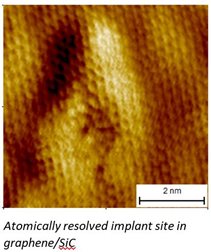Imaging ion implantation at the atomic scale
 A single impurity (foreign atom) encapsulated in a material, held in place by the host solid around it, is an ideal entity to be explored for quantum technology applications, as it can provide the quantum bits of information for quantum computers, or can emit photons one by one, necessary for secure quantum communication. To be able to exploit the plethora of possibilities for quantum technology applications that rely on foreign atoms embedded in a host material, one needs a repeatable, scalable, and deterministic method of positioning single atoms with nanometre precision. A suitable method for controlling the placement of dopant atoms is the single ion implantation and such an instrument is available at the University of Surrey - the Single Ion Multi‐species Positioning at Low Energy (SIMPLE). However, one of the main difficulties with the ion beam method, and thus the SIMPLE tool, is confirming that the ion is located where it is intended to be located. Furthermore, the amount of damage that the target lattice may incur during the implantation process, which requires careful selection of annealing times and temperatures to heal the damage, is not known.
A single impurity (foreign atom) encapsulated in a material, held in place by the host solid around it, is an ideal entity to be explored for quantum technology applications, as it can provide the quantum bits of information for quantum computers, or can emit photons one by one, necessary for secure quantum communication. To be able to exploit the plethora of possibilities for quantum technology applications that rely on foreign atoms embedded in a host material, one needs a repeatable, scalable, and deterministic method of positioning single atoms with nanometre precision. A suitable method for controlling the placement of dopant atoms is the single ion implantation and such an instrument is available at the University of Surrey - the Single Ion Multi‐species Positioning at Low Energy (SIMPLE). However, one of the main difficulties with the ion beam method, and thus the SIMPLE tool, is confirming that the ion is located where it is intended to be located. Furthermore, the amount of damage that the target lattice may incur during the implantation process, which requires careful selection of annealing times and temperatures to heal the damage, is not known.
QMS has worked with the University of Surrey to address these open questions in a feasibility study. Collaborators at Surrey’s Ion Beam Centre have successfully produced arrays of Au ions into graphene grown on silicon carbide, by controlled ion implantation with the SIMPLE tool. Arrays with 100, 10 and 1 ion per point were fabricated, and the spatial distribution associated with the Au implants, their immediate atomic environment, and the ion-implantation related damage were characterized by NPL using state-of-the-art scanning tunnelling microscopy (STM).
This technical feasibility study has assessed the viability of the investigation methods and identified the Nanoprobe STM system as a suitable tool to investigate the implanted sites at the atomic scale. Further STM experiments will verify the positional accuracy and statistics of implants to provide metrological input associated with the deterministic positioning of single ions.